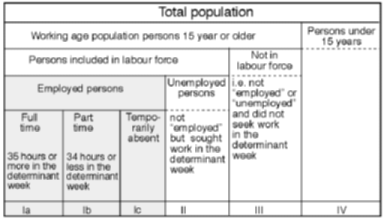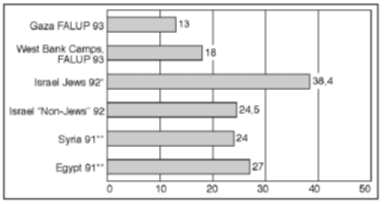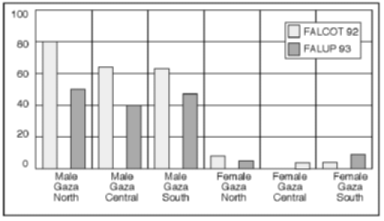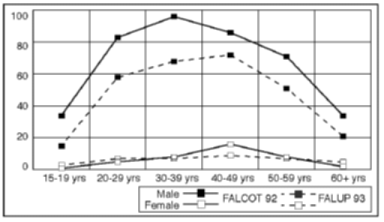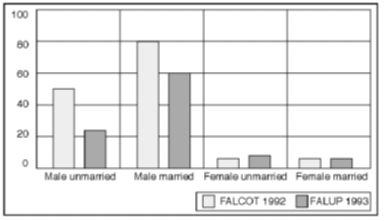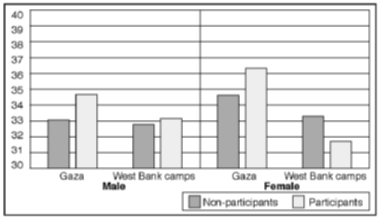
|
|||||||||||||||||||||||||||||||||||||||||||||||||||||||||||||||||||||||||||
|
(Chapter 2) Labour-force participation The size of the labour force is the most common indicator for the amount of labour available to the economy.1 Here we shall discuss labour-force participation in terms of three questions: First, what are the crude labour-force participation rates in Gaza and the West Bank refugee camps? Second, what determines labour-force participation in these areas? And finally, what is the current composition of the labour force by gender, age and educational background? Concepts of labour-force, employment and work Let us begin with a brief introduction of the adapted version of ILO's labour-force framework used in our analysis. Figure 2.1 gives an overview of the main categories used in the survey. (Heiberg & Øvensen 1993:182) The same categories were used in the previous FAFO survey. 2
Figure 2.1 Labour survey definitions used by FAFO. On the basis of a person's activities in the so-called "reference week" the labour force framework divides the survey population, 15 years or older, into three exhaustive and mutually exclusive categories: the employed, the unemployed, and persons outside the labour force. In the FALUP 93 survey the "reference week" varied over geographical areas in the time period from September to October 1993. Work activities conducted by prisoners, children under the age of 15, or by Israeli settlers are not included in the survey. No upper age limit for respondents was introduced because of the relatively small proportion of old persons in the population. The "employed" (box Ia, Ib and Ic) comprise all persons who worked at least one hour in the reference week, or persons who were temporarily absent. Persons working 34 hours or less during the reference week were defined as part-time workers; those working 35 hours or more as full-time workers. The "unemployed" (box II) are persons who did not work even one hour in the designated week, but who were actively seeking work. Employed and unemployed persons taken together make up the "currently economic active population" or "labour-force". Persons 15 years or older who are not "currently economic active" and children together make up the "not in the labour force" category (box III and IV). The ILO labour-force classification system is based on time worked rather than income. Working for many hours by no means guarantees correspondingly high income levels. On the contrary, many low-productivity jobs are implicitly based on long working hours that compensate for low hourly wages. All the same there are two main reasons for adhering to time- rather than income-based definitions for labour activities. First, income, unlike time worked, may be transferred among reference periods, and thus may be difficult to integrate into a labour-force framework with a short reference period. This problem is manifest in agricultural work where income appears when the produce is sold, even though work has been carried out throughout the whole agricultural season. Second, fear of taxation and scepticism towards strangers asking about money matters, make it extremely challenging to obtain reliable informationon income from employment. Under-reporting and concealment of money inflows would be the most likely result. Contrary to the intentions of the ILO definitions, many respondents in household surveys tend to understand "work" as regular employment only. This misunderstanding leads to frequent under-reporting of much labour activities typical of developing countries, like casual work, unpaid family work and work remunerated in kind. In particular, under-reporting of female labour activities may be expected. To cope with this problem a particular section focusing on income-generating household activities rather than individual persons, was included in the survey questionnaire. Even though most income-generating household activities take place in a domestic setting, some, like trade and services, are normally carried outside the home. In spite of several problematic borderline cases, "income-generating household activities" was thus applied to activities that brought supplementary income to households. Activities carried out in the home and resembling ordinary employment, like for example sub-contracting and piecework arrangements, were covered by the standard labour-force framework questions. Results from the section about income-generating household activities will be discussed further at the end of the section about employment patterns, page 63. Crude labour-force participation rates See tables 2.1 to 2.7 in appendix 3 as references to the discussion in this section. The proportion of the population involved in the labour force is called the crude labour-force participation rate. This rate may be seen as directly reflecting two factors: the age distribution of the population, and the propensity of various population categories to work. Figure 2.2 presents a comparison between crude labour-force participation rates in Gaza and the West Bank refugee camps with those in Syria and Egypt, and for Jews and "Non-Jews" in Israel.
Figure 2.International comparison of crude labor-force participation rates.
Percentage of all persons in respective populations The 1993 crude labour-force participation rates in Gaza and the West Bank refugee camps are not only far below that for Jews in Israel, but even lower than for other countries in the region. What can explain the extremely low participation rates in Gaza and the West Bank refugee camps? Table 2.1 gives some useful insights.
Table 2.1 Labour-force participation rates, by gender and source.
As in most Middle Eastern populations, except for Israeli Jews, much of the population in Gaza and the West Bank refugee camps are young people below working age. This very young population implies unfavourable dependency ratios i.e. the ratio of persons under and above working age to that of persons of working age and hence low crude labour-force participation rates. Children's work was omitted when the crude labour-force participation rates were estimated. Even though children's work does exist in the area, the nature of this work is such that reliable measurement would require a specially designed survey. Another important explanation for the extremely low crude labour-force participation rates in Gaza and the West Bank refugee camps is the very low participation rates for females which again is the pattern found in most Middle Eastern populations except for Israeli Jews. For adult males the FALCOT 92 report found relatively high labour-force participation rates in both Gaza and the West Bank refugee camps. The 1993 adult male rates, however, seem to have dropped dramatically in Gaza this decrease amounts to half of the males in the labour force in 1992. Which population groups have in particular seen a decrease in labour-force participation from 1992 to 1993? Figures 2.3, 2.4 and 2.5 compare Gaza labour-force participation by sub-region, refugee status and number of adult males in household, as measured by the FALUP 93 and the FALCOT 92 surveys. (The FALCOT 92 sample for the West Bank refugee camps was too small to permit comparison).
Figure 2.3 Gaza labour-force participation, by gender and sub-region.
Percentage of all adults in respective groups in Gaza
Figure 2.4 Gaza labour-force participation, by gender and refugee status.
Percentage of all adults in respective groups in Gaza
Figure 2.5 Gaza labour-force participation, by gender and number of adult males in household.
Percentage of all adults in respective groups in Gaza The greatest relative drop in male labour-force participation has been among non-refugees, who are over-represented in Greater Gaza City. Gaza males living in households with many other adult males have the largest reduction in labour-force participation. Figures 2.6, 2.7 and 2.8 compare Gaza labour-force participation in the FALUP 93 survey and the FALCOT 92 survey by individual characteristics such as gender, age, education and marital status. For males, the participation rate seems to have dropped for all groups, but most for those who are young, unmarried and less educated.
Figure 2.6 Gaza labour-force participation, by gender and age.
Percentage of all persons in respective groups in Gaza
Figure 2.7 Gaza labour-force participation, by gender and education.
Percentage of all adults in respective groups in Gaza
Figure 2.8 Gaza labour-force participation, by gender and martial status.
Percentage of all adults in respective groups in Gaza The substantial drop in adult male participation indicates the occurrence of a dramatic loss of employment after the March 1993 border closure. The employment situation among various socio-economic groups after the border closure will be discussed in greater detail in the section about under-utilization of labour. What determined labour-force participation in Gaza and the West Bank refugee camps in the autumn of 1993? As labour-force participation is influenced by numerous economic, political and cultural factors, working together in a complex interplay, a multi-variate analysis is required. Determinants of labour-force participation See appendix 3 as reference to the discussion in this section. An individual's position in the labour market may be seen as the outcome of a chain of decisions. Most important is the decision to be economically active or not i.e. whether the person will seek work. Among those who are economically active, additional decisions will have to be taken regarding the number of working hours, employment status, type, sector and workplace. Who make these decisions? Many economic models for Western countries are based on the assumption that decisions on labour activities are primarily the result of one adult individual maximizing his or her utility. This maximization process implies weighing up payment for work against alternative use of time, whether for other obligations or for leisure. The process is constrained by such factors as the person's physical ability to work, his or her skills, and the preferences of other household members. Palestinian society is family-based, so a model that sees decisions on income-generating activities basically as a household matter, seems more applicable. In this model, individual labour activities is considered primarily as the outcome of household rather than individual optimization strategies. In this sub-section we seek to highlight factors influencing the decision of individuals to become economically active, and possibly confirm the appropriateness of the household decision model. Our tool of analysis is logistic regression analysis estimating the propensity of individuals to join the labour force. Logistic regression is a statistical method where a dependent variable which describes an outcome or event is explained by one or more independent (explanatory) variables. A logistic regression model furnishes estimates of how the probability of the outcome is affected by the explanatory variables. Because the model focuses on outcomes, it is well suited for analyses of how decisions are influenced by the characteristics of individuals or groups. In our case, the outcome is whether or not an individual is a member of the labour force, i.e. if the decision to join the labour force has been taken. The explanatory variables may be seen as falling in two groups. The first group consists of variables relating to the position of individuals as ascribed by birth or inherent in their life cycle: gender, age, position in the household and marital status. The second group consists of variables that reflect the process of social differentiation more directly such as refugee status, education or place of residence. The analysis was carried out separately for men and women, since the determinants of male and female labour force participation are somewhat different. It appears that it is the group of variables ascribed by birth and inherent in the life cycle that has the most explanatory power. The exception is education, which is the only variable of the second group that we have found to influence labour force participation. As the West Bank sample comprises 97% refugees, it is only possible to gauge the effect of refugee status in Gaza, where it apparently does not influence labour force participation. Thus, the assumption of a strong influence of household optimization strategies on individual labour force participation is supported. If this interpretation is correct, we may draw two important conclusions at this point. Firstly, individual response and adaptation strategies to meet the economic shocks affecting the Occupied Territories are closely linked with household coping strategies. Secondly, public policy for influencing labour-force participation must not only aspire to change an individual's choice patterns, such as years of education, but also try to influence behavioural and attitudinal norms, such as what is seen as appropriate work for women. In the next section we present the composition of the labour force. This composition is, of course, a product of the factors identified as significant in the regression equations above. Composition of the labour force See tables 2.8 to 2.11 in appendix 3 as references to the discussion in this section. Labour resources available to the economy are dependent not only on the size, but also on the "quality" of the labour force. In particular, the workers' formal education and occupational training are important for labour productivity. Does the labour force in fact comprise the most productive segments of the adult population? Figure 2.9 presents a regional comparison of average age by gender and labour-force status.
Figure 2.9 Average age of adults, 15 years or older, by gender, main geographical
area and labour-force status As could be expected, those in the labour force in both main areas are better educated than are those outside the labour force. Regardless of sex, those in the labour force have on average 2-3 more years of education than non-participants. With regard to average age, differences by labour force status are small, due to two effects which tend to counteract each other. On the one hand, labour-force participation is lower among young adults because many are still students; on the other, it is also low among the elderly, who are often unwell. For male labour-force participants, regional differences in average age and years of education are relatively small. For (the small sample of) women, regional differences are larger, in particular with regard to average age. Interestingly, the difference between male and female labour-force participants takes opposite directions in Gaza and in the West Bank refugee camps. Gaza women are older and have less formal schooling than their male counterparts, whereas in the West Bank refugee camps the pattern is the inverse. Female participation in both areas is highest, relative to male participation, at the extremities of the educational ladder in particular at the top. This pattern was also observed in the FALCOT 92 report, which noted that "work" among women primarily tends to be understood as employment outside the home. Because of the greater acceptance of females working in professional rather than manual jobs, relatively many employed women hold mid-level professional jobs in public services (nursing, teaching, etc.). Table 2.1 clearly confirms the hypothesis of a dramatic reduction in male labour-force participation in Gaza and the West Bank refugee camps after the Israeli border closure in March 1993.
|
|||||||||||||||||||||||||||||||||||||||||||||||||||||||||||||||||||||||||||
 al@mashriq 961216 | |||||||||||||||||||||||||||||||||||||||||||||||||||||||||||||||||||||||||||
